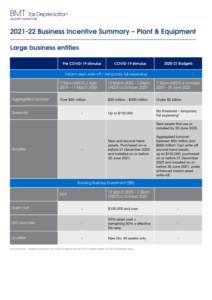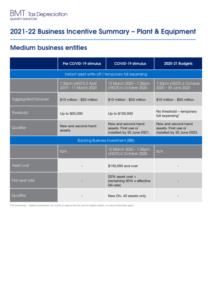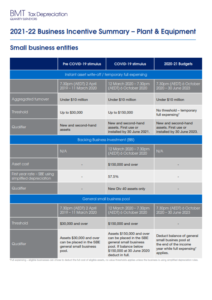Explanatory Memorandum – August 2021
ATO tax time support: COVID-19 and natural disasters
The ATO has a range of year-end tax time options to support taxpayers who have been affected by the COVID-19 pandemic and recent natural disasters.
Income statements can be accessed in ATO online services through myGov accounts from 14 July. The ATO also reminds those who may have lost, damaged or destroyed tax records due to natural disasters that some records can be accessed through their myGov account or their registered tax agent. For lost receipts, the ATO can accept “reasonable claims without evidence, so long as it’s not reasonably possible to access the original documents”. A justification may be required on how a claim is calculated.
The following provides a summary of tax treatment of different support schemes:
- JobKeeper – Payments received as an employee will be automatically included in the employee’s income statement as either salary and wages or as an allowance. However, sole traders who received JobKeeper payment on behalf of their business will need to include the payment as assessable income for the business.
- JobSeeker – Payments received will be automatically included in the tax return at the Government Payments and Allowances question from 14 July.
- Stand down payments – Employees receiving one-off or regular payments from their employer after being temporarily stood down due to COVID-19 should expect to see those payments automatically included in their income statement as part of their tax return.
- COVID-19 Disaster Payment for people affected by restrictions – The Australian Government (through Services Australia) COVID-19 Disaster Payment for people affected by restrictions is taxable. Taxpayers are advised to ensure they include this income when lodging their returns.
- Tax treatment of other assistance – The tax treatment of assistance payments can vary; the ATO website outlines how a range of disaster payments impact tax returns and includes guidance on COVID-19 payments, including the taxable pandemic leave disaster payment.
- Early access to superannuation – Early access to superannuation under the special arrangements due to COVID-19 is tax free and does not need to be declared in tax returns.
Assistant Tax Commissioner Tim Loh offered this piece of advice: “Even if you can’t pay, it’s still important to lodge on time. Once you lodge and have up-to-date records, [the ATO] can help you understand your tax position and find the best support for you.”
www.ato.gov.au/General/COVID-19/Government-grants-and-payments-during-COVID-19/.
Hardship priority processing of tax returns
It’s tax time again and if your business is experiencing financial difficulties due to the latest lockdowns, the ATO may be able to help by processing your tax return faster and expediting the release of any refund to you. To be eligible for priority processing, you’ll need to apply to the ATO and provide supporting documents (within four weeks of your submission) outlining your circumstances. “Financial difficulty” may include many situations such as disconnection of an essential service, pending legal action or repossession of a business vehicle.
According to the ATO, financial difficulty may occur in many situations, including but not limited to business closure, disconnection of an essential service, repossession of a business vehicle, pending legal action for unpaid debts, court orders, settlements and other necessities the business is responsible for.
As the circumstances of financial difficulty may vary, the supporting documents may be general (eg bank notices, overdraft calls, staff pay records, or eviction notices) or specific (eg disconnection notice for an essential service, repossession notice of a vehicle, notice of impending legal action, payment schedules or other legal documents).
Businesses can apply for ATO priority processing over the phone or through their tax professional after the lodgment of the tax return in question. Once the initial request for priority processing is received by the ATO, the applicant will be notified and contacted if more information is required. Processing will take more time for businesses that have lodged several years’ worth of income tax returns of amendments at the same time, and those that have unresolved tax debts.
Before lodging any priority processing request, the taxpayer should check the progress of their return through online services, the phone or their tax professional. If the return is in the final stages of processing, they may not need to lodge a priority processing request as the return will be finalised before the ATO has had an opportunity to consider the request.
Remember, priority processing of a business tax return doesn’t guarantee a refund. If the business has outstanding tax or other debts with Australian government agencies, the credit from a return may be used to pay down those debts.
For businesses that do not qualify for priority processing but are still experiencing hardship, there are various options to assist with cashflow, including adjusting GST registration and reporting, as well as varying PAYG instalments. If the business’s GST turnover is less than $75,000 they may be able to either cancel their GST registration or remain registered but report and pay GST annually or monthly. To vary PAYG instalments when business income is reduced, the business can lodge a variation on the next BAS or instalment notice and the varied amount will apply to the remaining instalments for the income year.
In addition, if business funds have been frozen or if the business owes the ATO under $100,000, it may be possible to pay the tax by instalments or the business may be eligible for a payment deferral. Remember, however, that the ATO doesn’t have the discretion to vary super contribution due dates or waive the super guarantee charge for late payments, so care needs to be taken to avoid penalties in this area.
Workplace giving versus salary sacrifice donations
Have your clients made donations either through workplace giving or salary sacrifice arrangements with their employers? If so, and they want to claim a deduction in their tax returns, it’s important for them to know that the tax treatment differs depending on which method they used to make the donation.
Essentially, workplace giving is a streamlined way for employees to regularly donate to charities and deductible gift recipients (DGRs). Usually a fixed portion of the employee’s salary is deducted from the employee’s pay each pay cycle and the employer forwards the donation on to the DGR. However, the amount of the employee’s gross salary remains the same and, depending on the employer’s payroll systems, the amount of tax paid by the employee each pay period may or may not be reduced to take into account the donation.
On the other hand, under a typical salary sacrificing donation arrangement, the employee agrees to have a portion of their salary donated to a DGR in return for the employer providing benefits of a similar value to the employee. The employee’s gross salary is reduced by the salary sacrificed amount and the amount of tax paid by the employee each pay period will be reduced; the employer makes the donation to the DGR.
If an employee has made a donation under workplace giving, they are able to claim a deduction in their tax return. This is regardless of whether or not the employer reduced the amount of tax paid each pay cycle to account for the amount of the donation. The employer will provide the employee with a letter or email stating the total amount donated to DGRs, and the financial year in which the donations were made.
Alternatively, the employer will provide the total amount of donations the employee made for the year in the employee’s payment summary, under the “Workplace giving” section.
Those who have made a donation to a DGR under a salary sacrifice arrangement, however, are not entitled to claim a deduction in their tax return, since it is the employer that is making the donation to the DGR – not the employee. Therefore, it is prudent for your clients to check whether they’ve donated under workplace giving or a salary sacrifice arrangement before claiming any deductions for donations to DGRs this year.
For taxpayers who have made donations outside the workplace, remember that for a donation to be deductible it must be made to a DGR and truly be a gift or donation (ie voluntarily transferring money or property without receiving or expecting to receive any material benefit or advantage in return) of $2 or more. Although, if you receive a token item for a donation (eg a lapel pin, wristband, sticker etc), you are still able to claim a deduction.
Receipts must be kept for donations made outside of workplace giving programs; however, if taxpayers have made donations of $2 or more to “bucket collections” conducted by an approved organisation they may be able to claim tax deductions for gifts up to $10 without a receipt. It should also be noted that many crowdfunding campaigns and sites are not run by DGRs, and subsequently any donations made to those causes should be carefully examined – it’s likely they will not be deductible.
Employers beware: increase in super guarantee
From 1 July 2021, the rate of super guarantee increased from 9.5% to 10%. Businesses using manual payroll processes should be careful that this change doesn’t lead to unintended underpayment of super, which may attract penalties. The rate employers should use to calculate super contributions depends on the date that they are paying their employees – it doesn’t matter if the work was performed in a different quarter. The new rate of 10% is the minimum percentage now required by law, but employers may pay super at a higher rate under an award or agreement.
Depending on how a business’s employment contracts are structured (eg a package, or base pay plus superannuation), the new extra 0.5% may either come from the employee’s existing gross pay or be extra payment on top of their salary.
Most payroll and accounting systems will have incorporated the increase in their super rate, but it’s always good to check. If your clients are still using a manual process to pay their employees, they will need to work out how much super to pay under the new rate. The process is fairly simple: they will just need to multiply an employee’s ordinary time earnings based on salary and wages paid in the quarter by 10% (or a higher rate if one applies under an award or agreement).
Remember, the rate used to calculate super contributions depends on the quarter that in which the business is paying its employees in. It does not matter if the work is performed in a different quarter. The 10% super guarantee applies to all super payments made after 1 July 2021.
Employers may not necessarily have to pay their employees’ super every pay cycle, but payment needs to be made at least four times a year (ie at least once each quarter). For the 1 July to 30 September quarter, super guarantee contributions are due by 28 October. Employers that miss this payment due date may be subject to the super guarantee charge and other penalties.
It should also be noted that some super funds, employment awards and contracts require employers to pay super more regularly than quarterly; therefore, various contractual obligations should be checked before moving to a quarterly remittance cycle.
This latest increase to 10% is by no means the last time the super guarantee rate will change over the next few years. From 1 July 2022 to 30 June 2023 (ie next financial year) the rate will increase to 10.5%, followed by another 0.5% point increase to 11% in the 2023–2024 financial year. So, employers will need to be on their toes to make sure the right amount of super guarantee is paid for the next few years.
COVID-19 lockdown support: NSW, Vic and SA
If your business or employment income has been affected by recent COVID-19 related lockdowns in New South Wales, Victoria and South Australia, financial help is available from both the state and Federal governments. Depending on the length of the lockdown, businesses may be eligible to receive a co-funded small and medium business support payment, as well as various cash grants.
Federal support
Businesses
For small and medium businesses, depending on the length of the lockdown, the Federal government will fund up to 50% small and medium business support payments to be administered by the states. For example, under the scheme, eligible entities in NSW will receive 40% of their NSW payroll payments – at a minimum of $1,500 and a maximum of $10,000 per week – if their turnover decreases by 30% from an equivalent two-week period in 2019.
Businesses will need to have an annual turnover of between $75,000 and $50 million. Non-employing businesses (eg sole traders) will also be eligible; however, the maximum payment will be set at $1,000 per week. In order to receive the payment, businesses will be required to maintain their full-time, part-time and long term casual staffing levels as at 13 July 2021.
The Federal government will also seek to make various state business grants tax exempt and provide support for taxpayers through the ATO with reduced payment plans, waiving interest charges on late payments and varying instalments on request. For individuals, the COVID-19 disaster payment of up to $600 will be available in any state or territory where a lockdown has been imposed.
Individuals
Where lockdowns or movement restrictions are in place or local government areas have been declared “hotspots”, the Federal government’s COVID-19 Disaster Payment is also activated. Individuals are eligible this payment if they have lost between eight and 19 hours of work (for a payment of $375), or 20 or more hours of work (for a payment of $600) because of restrictions under a state public health order.
The payments will be made in arrears and anyone affected can apply through myGov. More information about these payments and how to claim is available on the Services Australia website at www.servicesaustralia.gov.au/individuals/services/centrelink/covid-19-disaster-payment.
Source: www.pm.gov.au/media/nsw-covid-19-support-package-0;
www.servicesaustralia.gov.au/individuals/services/centrelink/covid-19-disaster-payment;
www.pm.gov.au/media/childcare-gap-fee-waiver-nsw-families-covid-affected-areas;
New South Wales
Eligible businesses with annual wages up to $10 million will be able to claim state government grants of between $7,500 and $15,000 under the business grants program. Smaller and micro businesses with turnover of between $30,000 and $75,000 that experience a decline in turnover of 30% will be eligible for a $1,500 payment per fortnight of restrictions.
Payroll tax waivers of 25% will be available for businesses that have Australian wages of between $1.2 million and $10 million and have experienced a 30% decline in turnover. In addition, payroll tax deferrals and interest free payment plans will be available.
Commercial, retail and residential landlords who provide rental relief to financially distressed tenants will be able to claim land tax relief equal to the value of rent deductions up to a maximum of 100% of the 2021 land tax liability. Residential landlords that are not liable for land tax may be able to claim a capped grant of up to $1,500 where they reduce rent for tenants.
Just as support for landlords has been ramped up, the NSW government will also be protecting tenants with a short-term eviction moratorium for rental arrears where a residential tenant suffers a loss of income of 25% due to COVID-19 and meets a range of other criteria. There will also be no recovery of security bonds, lockouts or evictions of impacted retail/commercial tenants prior to mediation.
Source: www.nsw.gov.au/media-releases/accelerated-2021-covid-19-business-support-grant-open;
www.nsw.gov.au/covid-19/businesses-sole-traders-and-small-not-for-profits;
www.smallbusiness.nsw.gov.au/resources/summary-covid-19-support-measures-micro-and-small-business;
www.service.nsw.gov.au/transaction/2021-covid-19-business-grant;
Victoria
Businesses in Victoria will be provided with cash grants from the state government. These payments will be automatically made to eligible businesses and sole traders to minimise delays. The state government estimates that up to 90,000 business that previously received assistance payments in relation to previous lockdowns will receive the new cash grant of $3,000 for licensed hospitality venues and $2,000 for other businesses.
Source: www.premier.vic.gov.au/cash-support-victorian-businesses-during-lockdown.
South Australia
Small and medium-sized businesses that suffer a significant loss of income or were forced to close as a result of South Australia’s seven-day lockdown are being offered a $3,000 emergency cash grant as part of a $100 million business support package. The package also includes a new $1,000 cash grant for eligible small businesses that don’t employ staff (eg non-employing sole traders).
Modelled on similar schemes in Victoria, NSW and WA, the SA grants will apply to businesses with a payroll of less than $10 million, with an annual turnover of $75,000 or more (in 2020–2021 or 2019–2020) and whose turnover reduced by at least 30% over the seven days from 20 July 2021 as a result of the lockdown.
In addition, the SA Government said it will provide fully-funded income support payments of up to $600 per week for eligible workers in regional SA who live or work outside of the Commonwealth-declared “hotspot” local government areas, and are therefore not entitled to the Federal $375 or $600 per week COVID-19 Disaster Payment.



